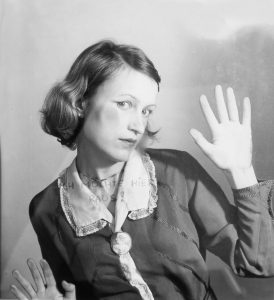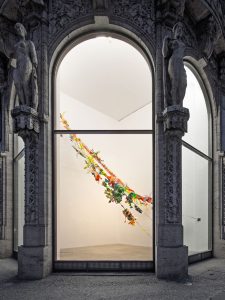 |
| Birgit Jürgenssen Ich möchte hier raus!, 1976/2006 Black and white photo 40 X 30 CM | 15 3/4 X 11 3/4 IN Edition 6/18 Photo: Gallery Thomas Schülte |
For the second year in a row, Gallery Quest organized a gallery tour during Gallery Night! All the galleries that are on view at the abc (art berlin contemporary) art fair open up their own spaces from 18:00- 21:00 hrs to show of the goodies.
On Friday night September 16th, we visited the Checkpoint Charlie area and our quest started at the renowned Galerie Thomas Schülte. The gallery is located in the beautiful Tuteur-Haus, a former fashion store that was confiscated by the Nazi’s because of their Jewish owners and nowadays one of the few preserved pre-war buildings in the area.
 |
| Fabian Marcaccio3DEP3, 2016 3D printed plastic, alkyd paint, silicone, hardware, rope, dimensions variable, photo Gallery Thomas Schülte |
On show in the corner space is the installation 3DEP3 by Argentinian artist Fabian Marcaccio (1963), with colorful jellyfish-like tentacles which contain 3D-printed objects, like an automatic machine gun or a syringe with wings. The objects function as hidden stories, making the tentacles seem like story threads.
Marcaccio likes to call his installations “paintants” (painting + mutant) and refers to his practice as an extended field of painting. Why call it a sculpture if you can call it a 3D painting? It sounds way better and now we can see the tentacles as brush strokes in the air.
In the backroom of the gallery we enter the photo exhibition “Die zu sein scheint, die bin ich“, with works from the seventies by four fabulous photographers: Katharina Sieverding (1944), Cindy Sherman (1954), Francesca Woodman (1958-1981) and Birgit Jürgenssen (1949-2003). All four use their own image in their work to communicate their ideas. They do this with their face or body, naked as well as clothed and with or without attributes like masks and make up.
 |
| Katharina Sieverding Transformer, 1973-1974 Digital slide projection, (86 Images), Loop Dimensions variable Photo: Gallery Thomas Schülte |
Haven’t we seen enough photo’s of women portraying themselves? The show is special, no doubt. Jürgenssen’s Polaroids are not often on show and the same goes for the very intimate work out of the short life of Francesca Woodman, who killed herself at the age of 21. But why show it now?, I asked Herr Schülte. What can portraits from the seventies tell us that is relevant now?
 |
| Telfar Clemens @ the 9th Berlin Biennale in the Akademie der Künste |
Visiting the 9th Berlin Biennale this summer, mister Schülte noticed that the issues Sieverding worked with, are still an issue now. While in the seventies, artists like David Bowie and Mick Jagger where exploring the border between men’s and women’s clothing, American fashion designer Telfar Clemens, on view at the Biennale, goes one step further in proposing to dissolve the difference altogether. The division only has marketing purposes and in actually most cultures it is perfectly normal for men to wear a dress.
A second reason for choosing these particular artists could be that nowadays there is a revival going on about so called “forgotten” female artists. Two recent examples from earlier this year are Anna Opperman @ Barbara Thumm and Kiki Kogelnik@ Galerie Köning. These artists where there all along, just not getting the attention in a male dominated era. Like now with Faceb-Insta-Twitter: if it doesn’t get enough likes/re-tweets/shares, it doesn’t exist.
3D pixelsNext stop was Alexander Levy gallery with (like Marcaccio) more post-medium work (who doesn’t love a good post-something?) by German artist Sinta Werner (1977). Her architectural photo collages are made after models and play with the illusion of space.
 |
| Sinta Werner @Alexander Levy |
In her work one can find many doublings, for she uses several prints of the same photo to create one work. In the photo above, she used the image in 2D, hanging on the wall and before it the same one in 3D, as a sculpture. Even better is the installation “Construction in the Moment” where she literally cut out a Photoshop cut-out and makes its pixels come to life in a 3D illusion in the gallery space.
We can find this doubling anywhere around us nowadays, in a world where there is a real and virtual version version of practically everything. From shopping to a library, from love to friendly chatting with your neighbor, google even made a virtual version of the earth itself.
BoundariesIn galerie Carlier/Gebauer Argentinian artist Sebastian Diaz Morales (1975) focuses in his work on the boundary between the two worlds, or more precise, the grey area between reality and fiction. This is also his playing field in the last part of the trilogy called “The Lost Object” on view in the gallery.
 |
| Richard Mosse, Moria, 2016, digital c-print on metallic paper, 126 x 431,5 cm. Photo: Carlier/Gebauer |
Showing the existence of different worlds is also a theme that can be found at Galerie Barbara Thumm who is showing works by English star artist Fiona Banner (1966), famous for putting whole fighter jets in the Tate Modern. At Barbara Thumm, only the airplane noses remain. Two of them are hanging on the wall next two each other, resembling big breasts. There is a whole industry around these airplane noses and it even has it’s own folky art form called nose art. Barbara Thumm told me, it took the artists years to get into this particular (male dominated) scene.
 |
| Fiona Banner exhibition view Galerie Barbara Thumm, 2016 Photo: Jens Ziehe |
The noses are covered in pinstripes, as are multiple objects in the exhibition like chairs and a very precise graphite drawing. Banner uses the pin stripe to portray London city life, the office jungle with it’s pin stripe uniforms.
In the film “Phantom” Banner shows a drone trying to ‘read’ a magazine she made together with Magnum photographer Paolo Pelligrin, which was published by her own publishing company The Vanity Press (which sums up the purpose of most women magazines). The drone doesn’t succeed, the magazine gets destroyed and blown away whenever it comes too close.
The magazine is called “Heart of Darkness”, it refers to a controversial 19th century novel by Joseph Conrad where the main character sets out on a journey into the ‘darkness; of Africa, only to find out is can be as dark as his home town Londen.
Bang!
Because ending with a bang is obligatory, König Galerie in the brutiful (ok, I stole that) St. Agnes church was our final destination. The space itself is a bang by itself, and so is everything you put in it. Even if it is a stain.
Because ending with a bang is obligatory, König Galerie in the brutiful (ok, I stole that) St. Agnes church was our final destination. The space itself is a bang by itself, and so is everything you put in it. Even if it is a stain.
 |
| Daniel Turner, Particle Processed Cafeteria @König Galerie |
And it is not a stain, it is a cafeteria. American artist Daniel Turner (1983) worked for a whole month together with three assistants, grinding down this cafeteria out of his home state West-Virginia. Well, the 35 chairs and 6 tables that is. In the form of dust, it was flown to Berlin and in the nave of the church, the artist mixed the powder with some kind of acid and bleach and sprayed it on the floor.
Question is how long can we call it a cafeteria? Do we need the visible form for that or can the transformation into a different shape also carry the memory? And if we do, when did it stop being a cafeteria and crossed the line into being something else?
The work is site specific, which means that after the exhibition it will be destroyed (or vacuumed), but it is also for sale. Only one barrel of dust was used for the installation, another four remain. So if you want, you can have the cafeteria sprayed in your very own dining room.
Geen opmerkingen:
Een reactie posten